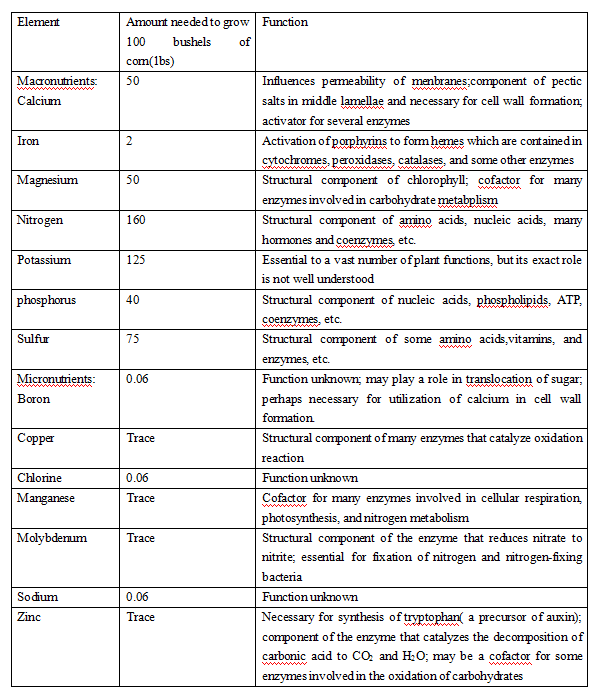2017-05-08 15:21来源:互联网作者:上海管理员
摘要:
(52C-Passage VI)
Most plants require specific substances known as minerals to grow and reproduce. The following table provides a list of the minerals essential to flowering plants and a description of their functions. The first seven listed are called macronutrients, since they are present in large quantities in the plants. The other minerals are called micronutrients because they are often present in trace amounts. The number of pounds of each mineral required to grow 100 bushels of corn is also depicted in the table.

Practice 5.1
According to the information presented in the table, flowering plants require iron in order to:
A. fix nitrogen.
B. activate porphyrins.
C. utilize calcium.
D. synthesize chlorophyll
Practice 5.2
A scientist hypothesized that some minerals are required in minute quantities and are used as components of enzymes by flowering plants. The data for which of the following minerals would support this hypothesis?
F. Calcium
G. Phosphorus
H. Sodium
J. Zinc
Practice 5.3
A botanist in South America found a new variety of corn identical to the type described in the table with the exception that it utilizes copper, instead of iron, in activating porphyrins. Approximately how many pounds of copper would you predict would be required to grow 100 bushels of this new corn?
A.0.3 lb
B. 2.0 lb
C. 4.0 lb
D. 50.0 lb
Practice 5.4
Which of the following conclusions about the mineral requirements of flowering plants is consistent with the data presented in the table?
F. Plants require larger amounts of minerals than are available in the soil.
G. Plants require some minerals whose functions remain unknown.
H. Deficiencies of certain minerals have little, if any, effect on plant growth.
J. The addition of minerals to the soil in the form of fertilizer results in a smaller yield of corn.
Practice 5.5
A researcher using the table concluded that minerals used as components of enzymes and as cofactors for enzymes are required in very small amounts. This is supported by the information given for all of the following elements EXCEPT:
A. magnesium.
B. manganese.
C. molybdenum.
D. zinc.
Answers for Practice 17-32: Practice 5 B J B G A
上海新航道学校作为业内良心ACT培训机构 ,坚持“英语”的理念,注重学术研究,注重培养学生的学习能力。想成为下一个高分学员?赶紧来新航道报名ACT培训班 吧!
免费领取最新剑桥雅思、TPO、SAT真题、百人留学备考群,名师答疑,助教监督,分享最新资讯,领取独家资料。
方法1:扫码添加新航道老师

微信号:shnc_2018
方法2:留下表单信息,老师会及时与您联系
免责声明
1、如转载本网原创文章,请表明出处;
2、本网转载媒体稿件旨在传播更多有益信息,并不代表同意该观点,本网不承担稿件侵权行为的连带责任;
3、如本网转载稿、资料分享涉及版权等问题,请作者见稿后速与新航道联系(电话:021-64380066),我们会第一时间删除。
地址:徐汇区文定路209号宝地文定商务中心1楼
乘车路线:地铁1/4号线上海体育馆、3/9号线宜山路站、11号线上海游泳馆站
总部地址:北京市海淀区中关村大街28-1号6层601 集团客服电话:400-097-9266 总部:北京新航道教育文化发展有限责任公司
Copyright © www.xhd.cn All Rights Reserved 京ICP备05069206


 微信公众号
微信公众号
 微信社群
微信社群